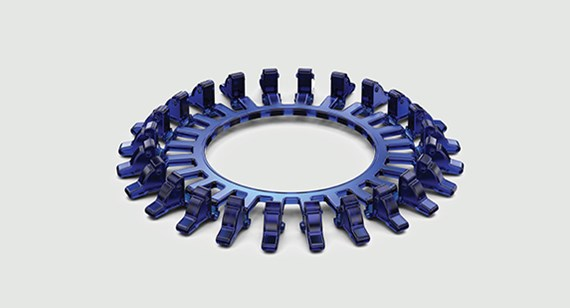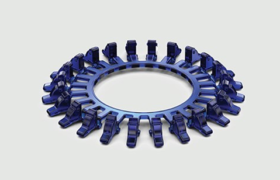Thermoplastic resins naturally possess mechanical properties that, depending on the material, provide injection-molded parts with strength, durability, impact resistance and other beneficial attributes. Nylon is strong. Polycarbonates have good temperature resistance. TPEs are flexible and absorb impact. Acrylic brings a high degree of transparency. Depending on a part’s geometry and its application, the base resin may work great. But when the performance of the standard plastic needs to be enhanced, additive fillings such as glass fibers, ceramic or mineral reinforcements can be compounded into materials.
Glass Fibers
Glass fibers are the most commonly used additives in plastic injection molding at FacFox. Depending on the percentage of fill, glass fibers can significantly improve the strength and rigidity of parts versus corresponding unfilled resins, but with strength comes brittleness. If a part does not have to endure high-impact stress and deflection, for example, and instead lives in a stable environment where it is merely supporting weight, then glass-filled parts work well.

Fill percentages vary, but typically range from 13 to 45 percent, in both the plastics we stock and the customer-supplied resins we accept. Glass-filled resins at FacFox include: ABS, nylon, acetal, polycarbonate, liquid crystal polymer (LCP), PBT, PET, PPS and high-performance resins like PEEK and PEI.
The addition of glass fibers also affects the molding process. A fiber is a strand that is equal to the length of the pellet. Standard fibers are about one-eighths of an inch long, and long glass fibers can be around three-eighths to one-half inch in length, depending on the extrusion. If we think of the fiber as a fish and the number of fibers as a school of fish, as the material flows through the cavity, the fish are lined up nose to tail swimming through the resin. As the school of fish nears a core pin that creates a hole in the part, the school must separate and swim around the obstruction. This changes the angle of the strand. So the more geometry that is in the way of the flow of resin, the more the strands are at random angles to each other.
Glass fibers restrict the shrink rate of the base resin. That restriction is different nose to tail than when perpendicular nose to tail. This creates nonlinear shrink and also exacerbates internal stress that increases warp risk. Unfilled resins typically have uniform shrink during cooling whereas glass fibers create different shrink factors, flow and transverse. Anticipating that change in shrink becomes very difficult in geometries with numerous holes, changes in flow length and shape, and changes in nominal wall thickness. Adding glass not only adds performance enhancements, but also risk.
As with any material, glass-filled or not, adding radii to part geometry can improve flow—it’s simply easier for resin to move around curved radii and fillets than against a 90-degree angle. Uniform wall thickness helps the resin cool at the same rate. Draft allows your molder to pack the part harder in the mold to fill the cross-section better. Smoothing out the flow path by placing the gate at the long axis of the part and minimizing through holes and turns in your part will help keep the glass fibers aligned with the anticipated shrink in the mold cavity. Paying attention to these concerns helps your molder minimize the inherent risk with fiber fillers.
Ceramic Fillers
With much less regularity, low percentages of ceramic filler and mineral reinforced additives are used to provide parts with increased temperature resistance. Like glass, the fillers also bring strength to parts, but again cause them to become more brittle. The caveat with these parts is that they are susceptible to cracking or chipping upon impact.
Think about the shape of your filler as well. Glass fiber is long and slender; it has a direction from nose to tail. Mineral fillers tend to be flat flakes that are dimensionally different and have direction. Powder is symmetric – it packs well and it’s more evenly distributed within the cross-section of the part, so it reduces risk of warp due to filler. It also typically does not change a uniform shrink rate to a linear shrink rate. It may only slightly reduce the shrink rate. Glass bead is another filler shape that is dimensionally different. Think of a ball pit. The bead is typically a ball shape; it stacks well and it increases the thermal deflection of the material, but typically does not increase the structural strength like glass-fiber fillers do. The ball pit rests uniformly and minimizes the effect on uniform shrink rates. So again, it helps to reduce internal stress caused by filler.
Thermally Conductive Resins
FacFox is also now supporting some thermally conductive resins based on geometry and ease of fill. The CoolPoly product line of thermally conductive thermoplastics use a special proprietary filler to create their conductive properties, which land somewhere between plastic and metal. The materials work well for those looking to reduce weight in parts and increase freedom of design. Keep in mind, however, that challenging geometry like thin walls and small features may prevent the use of thermally conductive resins.

Let’s switch gears now from additives that modify the mechanical properties of resins to ones that provide cosmetic modifications—colorants. FacFox offers a limited selection of colorants (about 45) as well as custom colorant (based on a Pantone number) that we can add to a base resin at no additional charge. Thermoplastic base resins primarily consist of black, natural and clear, and colorants can be added to the latter two. We generally employ a 3-percent salt-and-pepper mix, with smaller percentages for transparent resins like polycarbonate. Note that the mix is not an exact color match; even though a particular material can accept a particular colorant, part colors are approximate. If you upload a 3D CAD model, our AutoQuote system will automatically indicate which colorants are compatible with which materials.
Pre-Compounded Resin
When your product requires exact color matches or the use of multiple additives to ensure your parts and resin selection perform in their intended environment, you will need to supply your molder with a pre-compounded resin. Pre-compounding means a resin supplier like polyone.com or RTPcompany.com will mix all of the additives into one pellet ensuring uniform distribution and color. All pellets are the same in pre-compounded material rather than the salt-and-pepper mix that has a random dispersion of pellets.
Our team of applications engineers are not material experts; however, they have a well-rounded understanding of commonly used materials based on industry and geometry. They can help provide potential alternatives or suggest two or three different resins that may work. Simply running a few resins for testing will assist you in fine tuning your geometry that performs as needed in your product.
